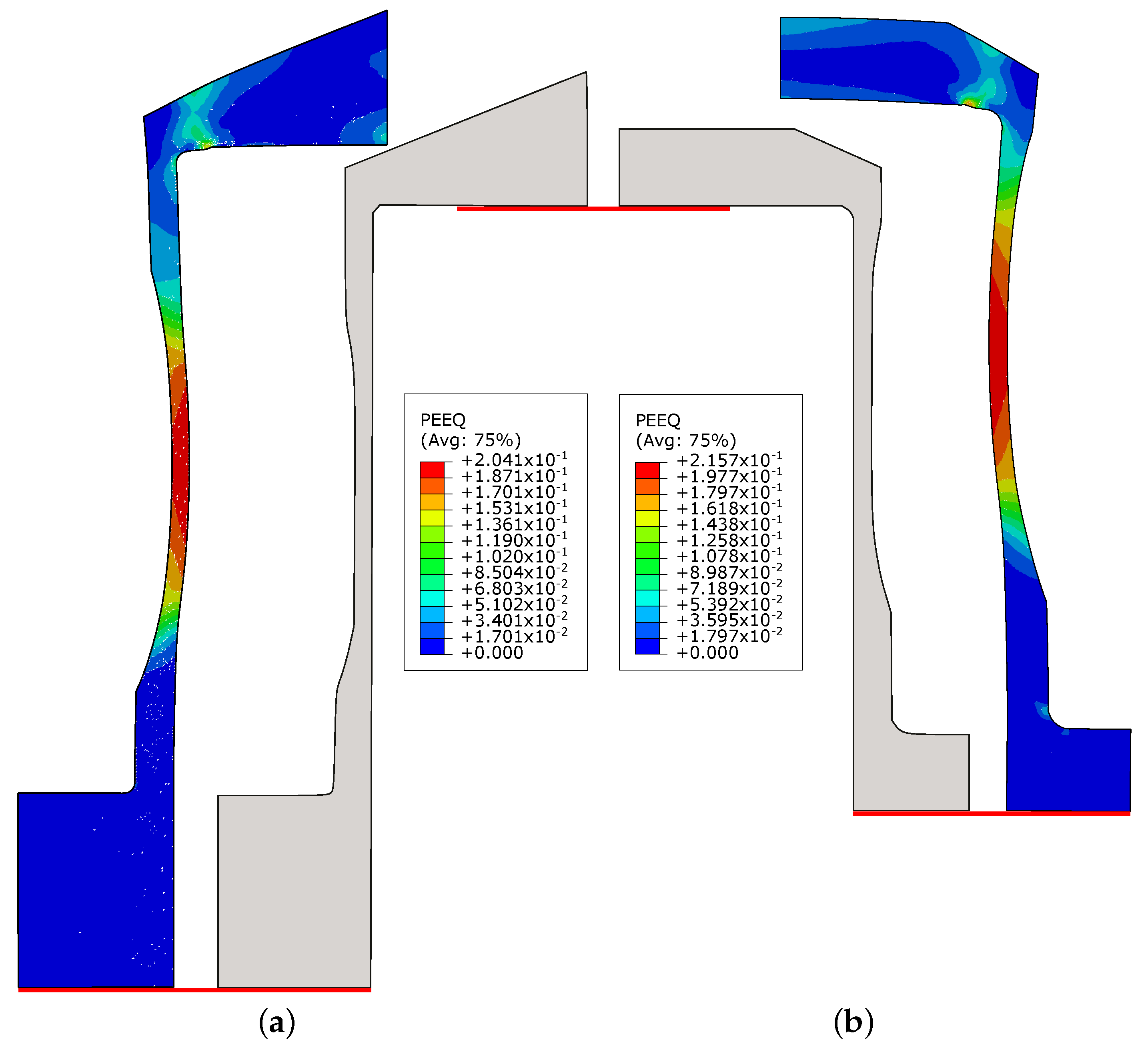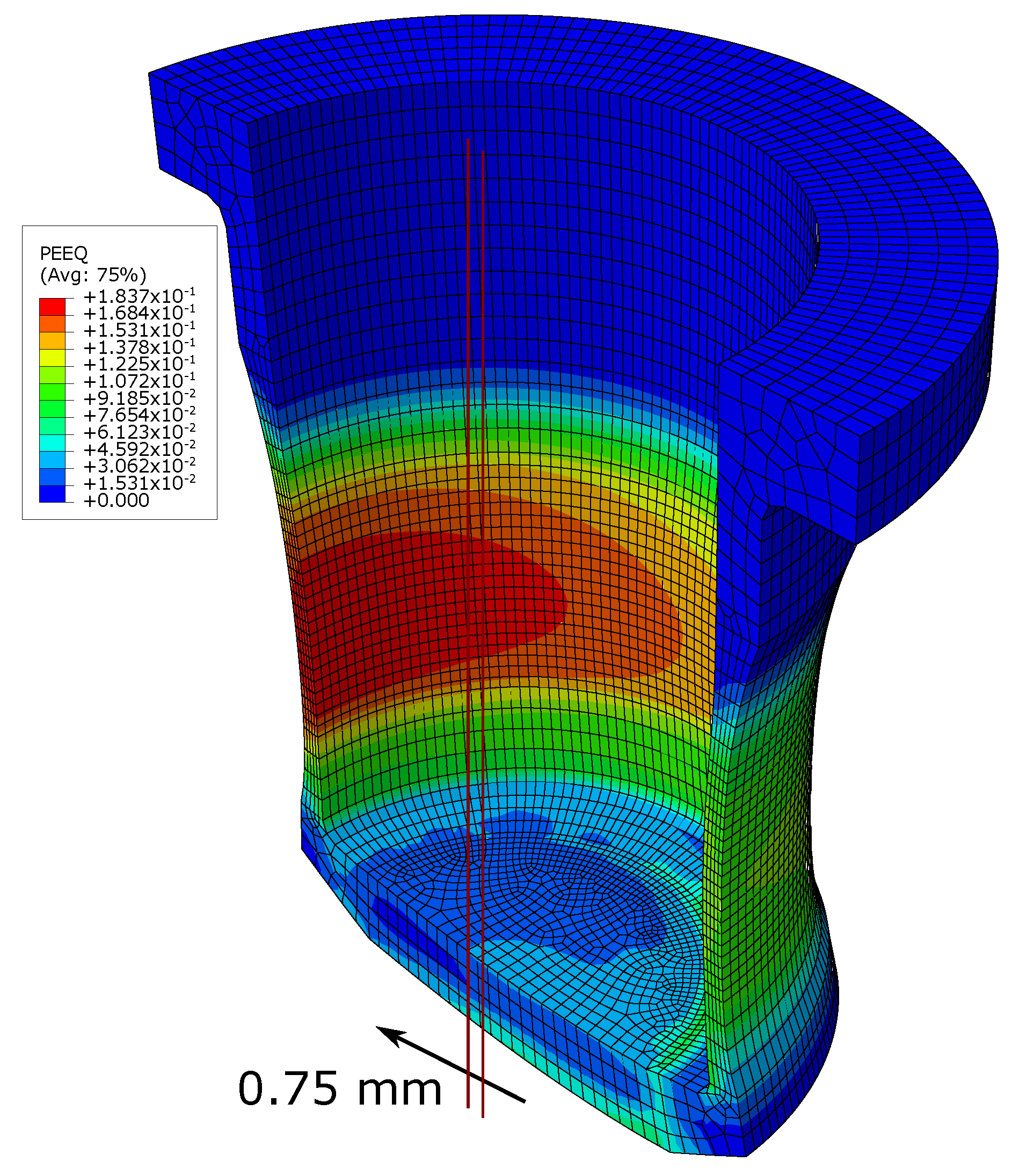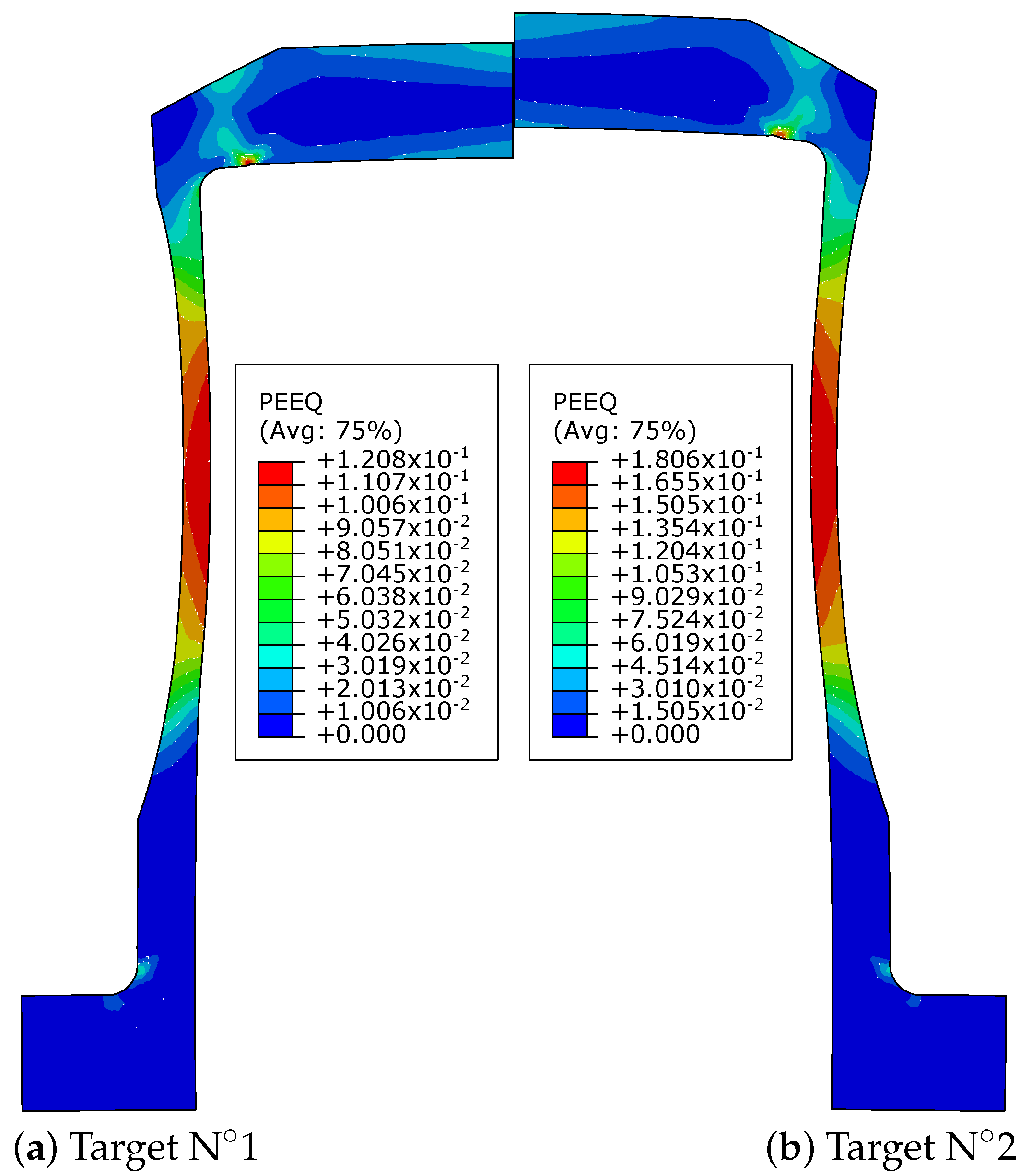1. Introduction
The thermomechanical behavior of metallic materials at high strain rates is frequently observed in military and civil applications. Due to the strain rate sensitivity, the deformation processes of metallic materials subjected to high strain rate mechanical stresses can differ significantly from the deformation processes of the same materials in static or quasi-static situations. In the case of quasi-static deformations, we have a situation of static equilibrium, i.e., any element of the body has a sum of forces acting on it close to zero. When a target is hit from the outside with a very high velocity, the stresses must move inside the bodies at specific velocities, and they may involve more complex mechanisms in the deformation processes. To gain knowledge of the dynamic mechanical properties of materials, there has been an increasing interest in high strain rate experimental methods over the past few decades. Among the dynamic stresses that can be applied to a sample (compression, tension, shear), dynamic tension is of particular interest for the mechanical characterization of the behavior of metallic materials.
One method used to characterize the behavior of materials subjected to dynamic tension is the Split Hopkinson Tensile Bar (SHTB) [
1,
2,
3,
4,
5,
6]. This corresponds to a modification of the Split Hopkinson Pressure Bar (SHPB) introduced by Kolsky [
7], for which strain rates ranging from
to
can be achieved [
8]. A typical specimen for the SHTB test has a dog-bone geometry with a midsection of a small cross-sectional area and ends with a larger cross-sectional area. A tensile load initially stored at the end section of the incident bar is released to generate the tensile load wave. The stress, strain, and strain rate determined from the recorded waves provide an accurate measure of the material behavior [
2]. This method has been improved over the years and recent advances allow specimen heating [
6], a wide strain rate loading range [
5], or combined tension–torsion or compression–torsion that is capable of loading a specimen with a torsional stress pulse synchronously at high strain rates [
9]. The results of SHTB tests with notched specimens combined with numerical simulation on Abaqus also allow Chen et al. [
3] to determine the parameters of the Johnson–Cook damage law of a material in addition to the parameters of the flow law.
As an alternative to the SHTB, Sturges et al. [
10] of the University of Leeds have proposed a so-called flying wedge test for high strain rate tensile testing, which includes two essential assemblies: a gas gun system to propel the wedge and a sliding mechanism to grip and deform the specimen. The kinetic energy of the flying wedge provides a sudden tensile pulse to the specimen. It can generate strain rates ranging from about
to over
. The study of the effective strain rate imposed on the specimen showed that the strain rate is not constant due to multiple reflections of the stress waves along the length of the specimen, as reported by Bonora et al. [
11]. More recently, Froustey et al. [
12] presented a device suitable for medium impact rates up to
for performing interrupted and failure tests. This one is based on a flywheel device used to load the specimen. The system is dedicated to displacement measurement and provides qualitative and quantitative information on the stretching mechanism leading to fracture.
Following the same approach as that used for the SHTB method, a technique for characterizing the behavior of materials subjected to dynamic tension was developed in this study by extending the Taylor impact technique [
13,
14,
15]. The first studies were carried out a few years ago in our laboratory and led to the development of a first version of the dynamic tensile test, for which the useful area of the target resembles that currently used by Liu et al. [
9] for combined tensile–torsional stress. In this test, the Taylor gas gun device is used to launch a projectile into a specially designed target with different impact velocities, and tensile deformation occurs mainly in the central region of the target. The strain rates of the dynamic tensile test range from
to
. In this paper, the previously proposed tensile target geometry [
16] was modified and optimized to achieve higher strain and elongation without reaching the critical state of target failure. For the present study, we also improved the experimental process and developed a complete numerical model of the test to validate the proposed optimization process.
Section 2 presents the experimental set-up of the device and the alternative version of the target for the dynamic tensile test.
Section 3 shows some results of the experimental tests made in our laboratory using the new geometry of the dynamic tensile target. Finally,
Section 4 is dedicated to the presentation of a numerical simulation of the dynamic tensile test using the Abaqus Explicit FEM code [
17] to validate the proposed new geometry of the specimen.
2. Experimental Set-Up
The experimental tensile test device installed in our laboratory consists of five elements: a Taylor gas gun used to launch the projectile in a velocity range of 30 to
, a laser light barrier projectile velocity measurement system, the projectile itself consisting of the assembly of a steel impactor head and a polycarbonate sabot, the target, specially designed for this application, and the target holder, which is unattached, used to obtain a perfect alignment of the target and the impactor, as shown in
Figure 1 from left to right.
In the Taylor impact technique, the history of stress, strain, and strain rate in the specimen cannot be recorded during impact. Instead, the final deformed shapes of the specimens are used as experimental responses for an inverse flow law parameter identification procedure such as that proposed by some previous work done in our laboratory [
18,
19,
20,
21]. Thus, in this type of approach, the identification of the parameters of the constitutive law is based on a post mortem analysis, i.e., on the final deformed shapes of the specimens. Basically, we use a method of identification by experimental/numerical simulation matching for which a numerical model of the experimental test is developed on Abaqus/Explicit. The parameters of the flow law used in the numerical simulation are then optimized in order to match the output of the numerical model in terms of final geometry to the experimental data. This reverse identification procedure is detailed in Ming [
20].
2.1. Experimental Device for the Taylor Impact Technique
The most important part of the Taylor impact technique is the Taylor gas gun, as shown in
Figure 2. It launches a projectile to perform the impact test, of which the propulsion is provided by nitrogen–oxygen compressed gas up to
, and the speed of a projectile with
weight ranges from 30 up to
.
The barrel guides the projectile to the exit of the launch chamber, where the target awaits impact. The choice of the impact speed is made by the value of the pressure in the firing tank and with the help of calibration tables made in the laboratory. Two laser barriers, apart, are placed at the end of the exit to measure the speed of the projectile just before impact, the global precision of this measure is about . The length and caliber of the barrel of our device are, respectively, and . A vacuum pump is used to empty the gun chamber before the test to avoid blast effects on the target.
A massive target support, with a mass of m =
, shown in
Figure 3 and
Figure 4, which is not fixed during impact, but rests on a double V, attached to support rails with screws, is used to support the target during impact and ensure proper alignment between the target and the projectile in the gas gun impact chamber. Due to the short distance between the end of the tube and the target, and considering that the target holder is placed on a double V, the same position of the specimen is assured between two consecutive shots.
The distance between the target and the barrel exit is kept as small as possible (about
) to ensure alignment during impact, i.e., the projectile just exits the barrel when it hits the target. This is possible thanks to the fact that the test is carried out in vacuum conditions, therefore without the presence of a blast at the front of the projectile. As we can see in
Figure 4, the two ends of the target support have different geometries, which are designed for different tests (dynamic traction test on the left side and Taylor compression test on the right side by adding a quasi-rigid disc inside the
diameter hole). The target support can provide the necessary inertial mass difference, allowing the targets to generate tensile deformation in the useful area. This approach was found to be better than using a set of screws to secure the target inside the impact chamber because it avoids shocks and preserves the integrity of the target guide rails. Nevertheless, this approach requires modifying the boundary conditions of the numerical model as proposed by Pantalé et al. [
21]. The material used for the target support is 42CrMo4 steel.
The projectile used in the dynamic tensile test, which is reported in
Figure 5, consists of a 42CrMo4 steel head and a polycarbonate sabot with the exact geometry as reported in
Figure 6. The sabot can ensure the tightness behind the projectile with an elastic ring and guide the projectile during its movement along the barrel. The total weight of the projectile is m =
g.
A dimensional measurement is carried out for the deformed specimens, which is mainly realized by a macro-photographic procedure. A digital camera Nikon D1X equipped with a
1:2.8 D macro objective is used to take pictures of the deformed specimens. This camera can obtain a digital image of
pixels having
spatial resolution for a macro ratio of
. The images of the deformed specimens are analyzed by a home-made software called
imageAnalyser [
22] (see
Figure 7 for a screen capture of this software). This software can build a 2D reference system to associate each pixel of the image with the real coordinate in millimeters. The profile of the specimen can be automatically extracted from the image by contour recognition and the coordinates of these points are output to a CVS file for further analysis. In addition to the image analysis system, some conventional techniques using measuring tools, e.g., calipers and inner and outer micrometers, are also employed to measure and confirm the dimensions of deformed specimens.
2.2. Optimization of the Target for the Dynamic Tensile Test
The initial geometry of the target for the previously designed dynamic tensile test, already published some years ago by Abichou et al. [
16], is reported in
Figure 8.
The thin area of the target is the so-called useful zone where tensile deformation mainly occurs. In the present work, the geometry of the target has been modified with regard to the previous approach and optimized in order to obtain higher strains and higher strain rates without reaching the critical state of the rupture of the specimen. The optimization of the tensile target is mainly based on the following considerations:
Lighten the zone where the projectile impacts the target (the top zone in
Figure 8) in order to reduce the inertia by making a flat top end;
Make the kinetic energy of the projectile better transferred to the useful cylindrical thin zone of the target and enlarge the connecting radii on either side of the thin area;
Increase the inner diameter of the target to to prevent contact between the projectile and the target because of the striction phenomena during the impact and keep the thickness of the wall 24 mm ().
The optimization process used was based on the numerical simulation of the impact test, in which some dimensions of the target were defined as being able to vary within certain limits with an increment of
in order to keep full dimensional values and to facilitate machining. The internal optimization software of the laboratory was then used to optimize these dimensions with the objective of decreasing the mass of the projectile, increasing the plastic deformation in the useful zone (within a certain limit in order not to lead to the rupture of the sample), for a fixed impact speed of
. The semi-automatic process used in this study is not detailed here, only the final results are indicated.
Figure 9 shows the final optimized geometry of the new target with the useful dimensions, while two photos showing a comparison of the external shape of both versions are presented in
Figure 10. Target mass was reduced from
to
for a 2017-T3 aluminum target.
A post mortem measurement, after the impact, is carried out as an evaluation of the deformation where a set of five dimensions of the tensile target are chosen to characterize the final shape of the target, including three dimensions along the axial direction (
,
, and
) and two dimensions along the radial direction (
and
), as illustrated in
Figure 11.
is the total height of the specimen (initial value is
),
is the distance between the two flat zones of the specimen (theoretical value is
but it is hard to measure and precision is low because of tolerances in the machining process),
is the initial length of the restricted zone (named after the fact that the initial length is
), and
and
are the internal and external radius of the specimen (initial values are
and
, respectively).
Before carrying out the dynamic tensile experiments, the outer surface of the optimized target, which corresponds to the length of
referred to in
Figure 11, is engraved by laser, as we can see in
Figure 10b. The dimensions and shape of the engraved grid lines are reported in
Figure 12. The purpose of this operation is to facilitate the geometrical measurement along the axial direction because without the grid lines there is no visible sign to locate
in the center zone of the target before and after the impact due to the large values of the two radii at each end of the useful zone. The laser engraving is conducted by the 5-axis laser machine Trumpf Trulaser Cell 3000, where welding and cutting in two or three dimensions are allowed. The laser output for this engraving operation is
, the axis speed is
, and the thickness of the engraved line is
. All the gaps between the 11 engraved lines are numbered from
up to
from the bottom to the top of the target, as reported in
Figure 12.
3. Experimental Tests
The dynamic tensile tests are conducted under different impact velocities
, and three of them have been selected to be discussed in detail because the deformations of these targets are entirely representative. These targets are numbered from
to
in ascending order of the impact velocity from
to
. Their geometrical measurement before and after the impact, for the five representative measures defined in
Section 2.2, are reported in
Table 1. We first consider the results of the targets
and
. During the impact, they are stretched in the axial direction (
,
, and
) and shortened in the radial direction (
and
) due to the tensile deformation occurring in the useful zone of the specimen.
Figure 13 shows some photos of their deformations and, as we can see from this later, both targets have been axisymmetrically deformed without rupture.
As for the target
, there is a crack in the center zone since the impact velocity of
exceeds the limit. Therefore, the results of the target
in
Table 1 are only rough estimates. Nevertheless, the deformation of the target
is significant. From
Figure 14a, we can see that the target
is damaged in the center zone instead of being penetrated from the top zone. It proves that the thickness of the top zone of the optimized target is enough for the damage to occur first in the center zone.
Figure 14b illustrates that the target
is impacted axisymmetrically, which means the deformation of the target is also axisymmetric.
Moreover, the deformations of the center zone of the targets
,
, and
are studied through the post mortem analysis. That is, the distances between every two grid lines are measured before and after deformation, respectively, using the homemade software
imageAnalyser [
22], in order to calculate the true strain. As shown in
Figure 12, the gaps between the grid lines are marked from
to
in the order from the bottom to the top of the target. The deformed length of these gaps and the corresponding longitudinal strain are reported in
Table 2 for the three targets. The longitudinal strain
is calculated from
From the overall point of view, the true strain gradually decreases from to . For target , the longitudinal strain in the zone cannot be evaluated due to the presence of the crack.
























